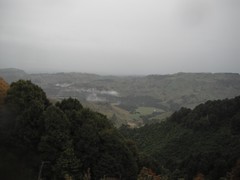
I wrote this little piece this morning for the school newsletter. To be honest I am not quite sure where it came from, but there you go it’s out now. Anyway I was quite proud of it, then I received an email from our local reporter asking permission to publish it in our Taihape Times. I had a good hard think about it, and he sent a second one pleading so I said yes. Anyway hopefully I get a few people thinking.
Earlier this week I was having a chat with our senior students about how different primary school is compared to when attended in the Eighties. The kids were amazed when I explained that we had ask permission to leave our desks, go to the toilet or to get a drink of water. For these 21st Century Kids who were sitting on a cushion in front of the fire, doing their math book work while munching on an apple, the thought of being confined to one’s desk was just abhorrent.
I guess that’s what much of education was like back in the bad old days (which really is not so long ago). Children confined to a classroom, a year group, an achievement level, a set of standards or a desk. Learning was confined to Three Rs, and occasional PE.
According to Sir Ken Robinson and many educational experts, this is called the Industrial Model. Schools were formed to create batches of cookie cutter graduates that fit into an industrialized society. Below is a link to a fabulous Youtube Video, which explains how education needs to change and move away from this industrial model in order to meet the dynamic needs of our 21st Century society.
http://www.youtube.com/watch?v=zDZFcDGpL4U
The wonderful thing is, that New Zealand is already way ahead of the ball game, when it comes to dynamic education, with it’s world renowned New Zealand Curriculum. The Vision Statement for our curriculum is to have “young people who will be confident, connected, actively involved, lifelong learners”. How wonderful is that!
I believe that it is really important that our community have a long hard think and begin a robust conversation about what we really want for our children in education. Our society has changed irrevocability, as a consequence shouldn’t our education system also evolve to meet our society’s needs?
Lately the media has been full of accusations that our education system is in a ‘crisis’, and how we need to get back to the ‘basics’. Well, I say (and I will probably get in trouble for this but …) rubbish to that! Can’t you remember how bored and uninspired you were at school? Sure, if you were lucky you had one or two teachers who inspired you and broke the mold, but in general we were confined to our desks waiting for lunch time.
As I watched the kids this term, bubbling with excitement while preparing the school fundraising fair, experimenting with technology and science, and interacting with Richie McCaw on our Richie Day a horrible thought occurred to me. If we went back to the basics, if we conformed to aspirational standards and league tables, if we turned to national testing like Australia, we wouldn’t have been able to participate in any of our exciting learning this term. We would have been too busy pushing our children into their prescribed achievement levels, so that we could report that they weren’t ‘failing’.
I don’t know, but it doesn’t seem right to me. I just want the school I teach in to be a place that inspires children to shine in all areas of their life, not just where the politicians deem necessary.
So that’s what I want for education, my question is what do you want? And do those Suits down in Wellington know it?
